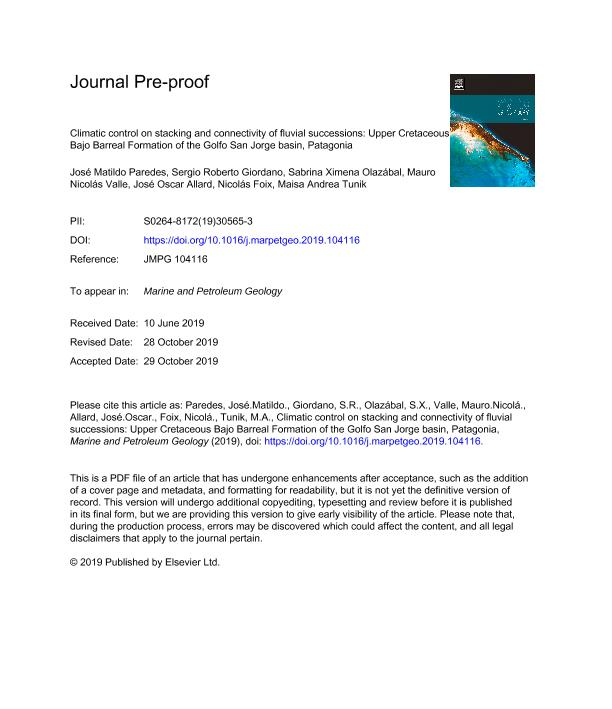Mostrar el registro sencillo del ítem
dc.contributor.author
Paredes, José Matildo

dc.contributor.author
Giordano, Sergio Roberto

dc.contributor.author
Olazábal, Sabrina Ximena

dc.contributor.author
Valle, Mauro Nicolás

dc.contributor.author
Allard, José Oscar
dc.contributor.author
Foix, Nicolas

dc.contributor.author
Tunik, Maisa Andrea

dc.date.available
2021-09-10T17:37:48Z
dc.date.issued
2020-03
dc.identifier.citation
Paredes, José Matildo; Giordano, Sergio Roberto; Olazábal, Sabrina Ximena; Valle, Mauro Nicolás; Allard, José Oscar; et al.; Climatic control on stacking and connectivity of fluvial successions: Upper Cretaceous Bajo Barreal Formation of the Golfo San Jorge basin, Patagonia; Elsevier; Marine And Petroleum Geology; 113; 3-2020; 1-66
dc.identifier.issn
0264-8172
dc.identifier.uri
http://hdl.handle.net/11336/140122
dc.description.abstract
Climate impact on alluvial organization owing to its control on water availability and sediment delivery within the catchment, but temporal changes in stacking patterns are often interpreted to reflect changes in subsidence and base level. To test for evidence of climatic control on the stacking pattern, we study an outcrop succession with two styles of stacking within the Upper Cretaceous Bajo Barreal Formation in the Cerro Ballena anticline, Golfo San Jorge Basin, Argentina. The 385 m thick and 2.5 km wide exposure has layer-cake geometry, lacking either large-scale erosional surfaces, fluvial terraces, or evident paleosols, dismissing either local tectonic activity or base-levels shifts. Rooted in a paleohydrological study recognizing upward increasing in both channel width and flow depth of formative rivers, we use spectral gamma-ray logs, x-ray diffraction in mudstones, and sandstone petrography to understand the controls on the stacking pattern. At the base, Section A consists of small-scale, isolated channels fills in a siliciclastic floodplain with sand:mud ratio of ~1:6, whereas the overlying Section B has a sand-mud ratio of ~1:3, with larger-scale channels and greater inter-connectivity within a volcaniclastic floodplain. Upward reduction in K percentage through Section A parallel with increasing kaolinite content, and mudstone samples from Section B contains a higher proportion of kaolinite than Section A samples, evidencing an upward increase in paleo-weathering in humid conditions. Detrital components of Section A indicate several volcanic sources (e.g., basic-intermediate components derived from the Middle Jurassic Bahía Laura Group and acidic components sourced from the Andes Cordillera), whereas Section B exclusively contains acidic clasts derived from the Andes Cordillera. Simultaneous changes in detrital constituents, suspended load type, and increasing scale of the rivers in Section B occur coeval with increases in channel inter-connectivity, here related to the increase of river discharge and sediment supply in a humid climate, favoring more frequent avulsions or higher channel migration rates in a relatively flat geomorphic scenario. The study demonstrates, combining independent lines of evidence, that climate change can impact the stacking and connectivity of potential sandstone reservoirs.
dc.format
application/pdf
dc.language.iso
eng
dc.publisher
Elsevier

dc.rights
info:eu-repo/semantics/openAccess
dc.rights.uri
https://creativecommons.org/licenses/by-nc-nd/2.5/ar/
dc.subject
CHEMICAL WEATHERING
dc.subject
DETRITAL PROVENANCE CHANGES
dc.subject
HUMID CLIMATE
dc.subject
KAOLINITE VARIATION
dc.subject
OUTCROP GAMMA-RAY SPECTRA
dc.subject
PATAGONIA
dc.subject
UPPER CRETACEOUS
dc.subject.classification
Geología

dc.subject.classification
Ciencias de la Tierra y relacionadas con el Medio Ambiente

dc.subject.classification
CIENCIAS NATURALES Y EXACTAS

dc.title
Climatic control on stacking and connectivity of fluvial successions: Upper Cretaceous Bajo Barreal Formation of the Golfo San Jorge basin, Patagonia
dc.type
info:eu-repo/semantics/article
dc.type
info:ar-repo/semantics/artículo
dc.type
info:eu-repo/semantics/publishedVersion
dc.date.updated
2021-09-06T20:38:22Z
dc.journal.volume
113
dc.journal.pagination
1-66
dc.journal.pais
Países Bajos

dc.journal.ciudad
Amsterdam
dc.description.fil
Fil: Paredes, José Matildo. Consejo Nacional de Investigaciones Científicas y Técnicas; Argentina. Universidad Nacional de la Patagonia "San Juan Bosco"; Argentina
dc.description.fil
Fil: Giordano, Sergio Roberto. No especifíca;
dc.description.fil
Fil: Olazábal, Sabrina Ximena. Universidad Nacional de la Patagonia "San Juan Bosco"; Argentina
dc.description.fil
Fil: Valle, Mauro Nicolás. Universidad Nacional de la Patagonia "San Juan Bosco"; Argentina. Consejo Nacional de Investigaciones Científicas y Técnicas; Argentina
dc.description.fil
Fil: Allard, José Oscar. Universidad Nacional de la Patagonia "San Juan Bosco"; Argentina
dc.description.fil
Fil: Foix, Nicolas. Universidad Nacional de la Patagonia "San Juan Bosco"; Argentina. Consejo Nacional de Investigaciones Científicas y Técnicas; Argentina
dc.description.fil
Fil: Tunik, Maisa Andrea. Consejo Nacional de Investigaciones Científicas y Técnicas. Centro Científico Tecnológico Conicet - Patagonia Norte. Instituto de Investigación en Paleobiología y Geología; Argentina
dc.journal.title
Marine And Petroleum Geology

dc.relation.alternativeid
info:eu-repo/semantics/altIdentifier/url/https://linkinghub.elsevier.com/retrieve/pii/S0264817219305653
dc.relation.alternativeid
info:eu-repo/semantics/altIdentifier/doi/http://dx.doi.org/10.1016/j.marpetgeo.2019.104116
Archivos asociados
